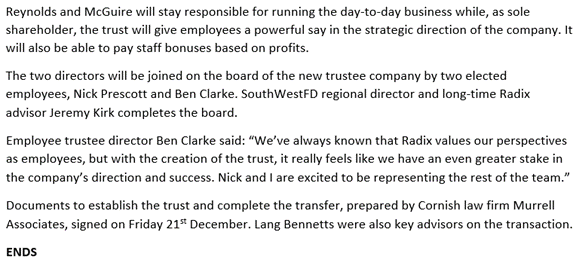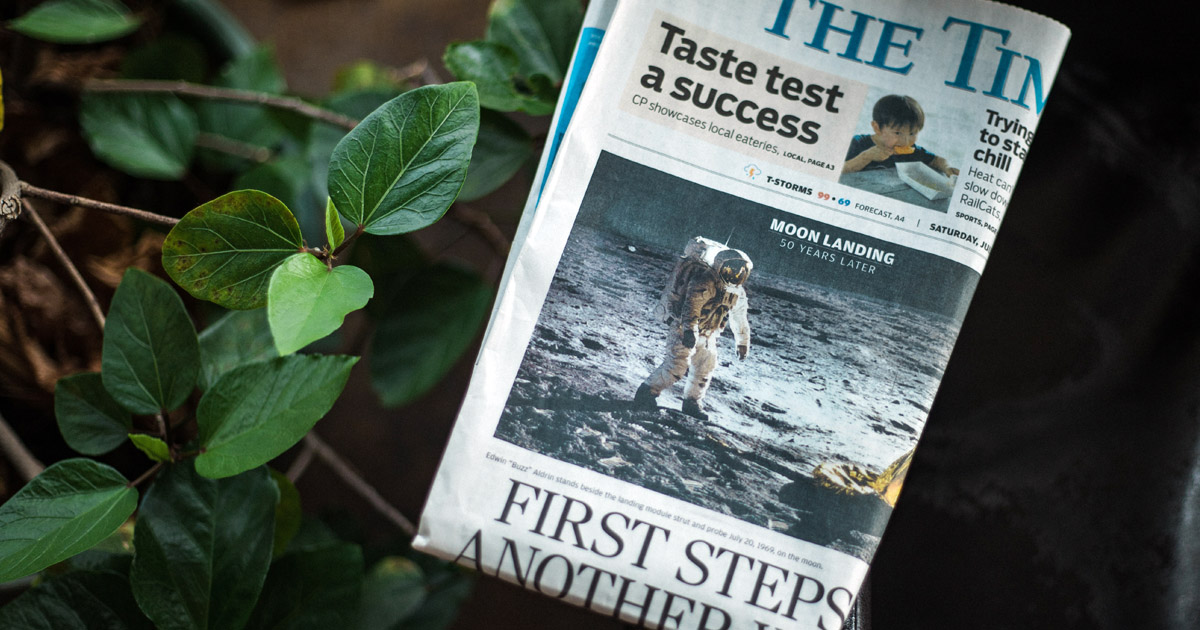I have it on good authority that B2B journalists still get hundreds of press releases each day. (And that almost none of them are any good.) That means three things: press releases are still popular, yours has to work really hard to stand out, and there’s plenty of opportunity if you do get it right.
So, how do you write a rollicking good B2B press release?
At Radix, we’re copywriters, not PR experts. We don’t have a thick book of contacts, we’re not great at crisis communications, and we can’t help you get your article placed. But we do know a thing or two about turning B2B subjects into a compelling story, and writing them in a way that fits a particular audience and outcome.
When a client asks us to write a press release, it gives us the chance to practise the three most fundamental skills of B2B copywriting:
- Empathising with the reader
- Spotting what’s important about a complex-looking subject
- Telling that story in a simple, compelling way
The more a writer gets to exercise those particular muscles, the better. It will pay off in all the other kinds of B2B content we write.
Writing a B2B press release is easy; writing a good one is hard
In his 2016 blog* The 15 B2B copywriters I don’t want to be, Doug Kessler wrote:
“Press releases aren’t writing. They’re typing.
“Almost anyone can fill in the blanks of this highly constrained corporate template (‘We’re thrilled to welcome Attila to our growing Hun team.’) but no one will ever read a press release even though lots of places publish them.”
That hurts a bit – because press releases made me the copywriter I am. Every day, people would come to my desk with boring, jargon-stuffed policies and reports, and I had to turn them into something interesting. I had to make them news.
And after three years, I got pretty good. And I learned something important: everything is interesting if you can find the right audience, and tell them what it really means.
Filling in a corporate template with bland, boastful words does not achieve this. It pays no attention to the audience, it doesn’t make life easy for the journalist, it makes no effort to be relevant or interesting. So sure, a press release like that is awful, and I wouldn’t want to have to write one either.
But there’s another way.
Five basic principles of a good B2B press release
I’ll get on to some of the basic “what goes where” detail shortly. But first, here are some important ideas to bear in mind before you even start:
1. Know who your reader is, and what they care about
Who reads the publication or website you’re writing for? How much do they already know, and how is your story relevant to them? That’s the person you’re writing to, not (primarily) the journalist. And if there’s honestly no earthly reason why they would care, why are you writing this press release at all?
In B2B, a good digital transformation story might fascinate a CIO or CTO. The CISO probably couldn’t care less. Choose your reader wisely.
2. Put the most interesting story (for that audience) first
Your press release is going to hit a crowded inbox. So if the interesting part is halfway down, forget it. This isn’t a long article with time to unfold – you need to find the bit your audience cares about the most, and make it the very first thing you say.
And yes, if different audiences will care about different bits of the story, that might well mean you need more than one version of your press release.
3. Treat your press release like a news story
You’re not writing an announcement; you’re writing news. And when did you ever see a journalist start a report with “We are delighted to announce…”?
So write like a journalist. Keep it objective, in the third person. While you’re at it, remember that the news is about a thing that has happened. Your first sentence needs to say what that thing is (and make it clear why they should care).
4. Facts in the story, feelings in the quote
Don’t say anything in your press release that isn’t verifiably true. And I don’t just mean “don’t lie”; I also mean “don’t boast”. If you can’t prove something’s unique, essential, wonderful, or iconic – or anything that an unbiased journalist wouldn’t say about it, basically – then don’t say it.
The only exception is the bit where you quote a spokesperson. This is your opportunity to add colour, so don’t waste it on bald facts you could put elsewhere. Instead, use the quote to react, interpret, and explain. And when you do, make the person sound as human as you can get away with. You know the bit where it’s wonderful and important and everyone’s chuffed to bits? That goes here.
5. Aim for the cut and paste
I know I’ve written a good press release when I see my copy word for word, with a journalist’s name above them.
Especially in B2B, fewer and fewer journalists are responsible for making more and more content. The job of the press release is to make their life a little bit easier – by enabling them to cut and paste large chunks (or even the whole thing if they’re really busy).
To help that process, copy the style of the publication or website you’re writing for. Make your release a similar length to other pieces there, and start it the same way. Pay particular attention to punctuation, vocabulary, spelling, and other conventions – like whether they use people’s first names after the initial mention, or surnames.
For example: did you notice in Doug’s quote above I re-opened the speechmarks for the second paragraph without having closed the preceding ones? That’s how it works in most magazines (even though it looks a bit odd).
Similarly, sending your press release in a cut-and-paste-unfriendly format like PDF is probably not going to help your cause.
The anatomy of a B2B press release
OK, let’s look at a real-life example, to see what you might want to put in your release. From the top of the page down (but not necessarily the order in which you should write them), here’s what you should include:
1. The date
![]()
You can also say whether it’s OK to release the information now (“For immediate release”), or if you’re embargoing an announcement until a certain date (“Embargo until”).
You might also want to include the city you’re writing from if it’s relevant, or if the media you’re targeting usually include that in their news.
2. Your headline and subhead

As you’d expect: tell the story in as few words as you can, in a way that’s relevant to your audience. Use the present tense, and don’t worry about making it a whole sentence.
Pro tip: Headline puns are always tempting, but don’t sacrifice your first priority, which is to make the story clear. Also, bear in mind you’re taking away the journalist’s satisfaction at making the pun for themselves, and/or the fact that, in a niche B2B publication, they’ve heard all the puns a million times anyway.
In this example, we were writing for regional business press, so our location (which this audience cares about) is more important than the fact we work in B2B tech (which, round here, they mostly don’t). So that’s what we lead with.
3. Your nutshell paragraph
![]()
This is arguably the most valuable skill in all B2B copywriting, and never a bad way to start any piece of B2B content. Tell your audience what has happened – and make them care – in five seconds flat. Even if your reader leaves at this point, they should know everything they need to. This section will also do more than any other to attract the journalist’s attention… or not.
And remember, as this is the start of your story, we’re now into the past tense, and whole sentences.
Pro tip: Imagine you’ve heard the whole story, and run to the top of a steep hill to tell your audience. You’re out of breath and have five seconds before you pass out. What do you say?
In this example, we re-state the local connection and take a very broad view of what we do, to suit the regional business audience. And we give the simplest, clearest version of what’s happened and why it’s interesting.
4. A paragraph or two unpacking the story

Now you can explain the story in a bit more detail than you’d included in your nutshell. Think of the questions your audience has in mind, and answer them.
Pro tip: It’s not a hard and fast rule, but keep the paragraphs in your press release to two lines or less where you can. It’ll keep the story moving on, and make you explain things simply. Also, you’ll avoid huge long chunks of text if you’re printed in column format.
In our example, the likely questions include “Who the hell are they?” and “What on earth is an employee-owned trust?”
5. An engaging, human-sounding quote

As we’ve established, this is your chance to break out of plain facts and corporate speak, and bring a bit of emotion and interpretation.
Pro tip: If you’re asking spokespeople for quotes, ban them from using cliché words like “delighted”, “prestigious”, and “recognition”. Having the obvious go-to phrases taken away will likely push them towards more interesting and authentic ways of expressing themselves.
In our case, Sophie gives a positive and common-sense explanation of the reasons for setting up Radix’s EOT. She says how she feels about it – which would never work in the body copy.
6. Wrapping up

After three or four paragraphs, the main part of your story should be done. If there’s more to add, you can cycle around one or two explanatory paragraphs, then a quote… and repeat. (If you’re working with multiple stakeholders who all want a say, remind them that the more quotes you include, the less chance that anyone will get their words published.)
Again, Ben’s excitement in this example is exactly the kind of thing you can only say in a quote.
Pro tip: Busy journalists editing for length will often do so from the bottom upwards. So even if the second half of your press release is lovely, it shouldn’t include anything you would be horrified to lose. Think of it like a slow-worm, which can jettison its tail to escape from a predator… and put all the important stuff at the front.
Finish with a “what happens next” line or somewhere people can get more information. But crucially, stay in character as the journalist; this is not a business CTA. (Lots of companies get to this point, then ruin everything by saying “please click the link for more information”, as if a news editor is suddenly going to plead with their reader on your behalf.)
Oh, and remember to write “ENDS” where your story finishes, or you could end up with your personal contact details in the paper too. I’ve been there, and it’s… interesting.
7. Press release housekeeping

The first thing to do after your press release is to tell them where they can get more information. If it’s a multi-page affair, you could include those details in the footer of every page. Journalists work to deadlines, so make sure someone is on hand to answer the email or phone.
Likewise, if you’ve quoted a spokesperson, it would make sense to have them available to answer any follow-up questions; don’t send this out the night before they go on holiday.
You can also use this opportunity to add a “notes for editors” section to tell the journalist any additional background information you think they ought to know, but which is not strictly relevant to this particular story. It’s a nice way to get all the clutter out of your press release, and make the story nice and sharp.
And if you’ve attached a photo, include an image caption for accessibility and publishing purposes.
What’s the difference between B2B and B2C press releases?
The essence of a good press release is pretty much the same for B2B and B2C: a strong and succinct story, that’s relevant to the audience’s interest. The big difference is that the interests of that audience (and the remit of the media) can often be very sharply defined – remember, are you writing for the CIO, or the CISO?
It also has to be said that B2B trade news media are sometimes more overtly commercial than B2C (to the extent that my friends who work in mainstream news are often shocked at the difference). Some trade magazines might have product launch sections, after the news, where a brand can guarantee coverage in return for a nominal “colour separation fee”. This has benefits (guaranteed coverage, be as promotional as you like) and drawbacks (everyone else is saying whatever they like too, so it’s probably not a very interesting or authoritative page).
There’s still a place for a (good) B2B press release
A good press release can still serve you well – especially in B2B. It can bring you into the conversation in an industry’s trade media, and help you to be present where the sector hangs out. If somebody Googles your brand, they’ll find you’ve been mentioned regularly in the right of places. It gives you a bit of a halo. Especially for up-and-coming brands, that can make a lot of difference.
And, from my point of view, press releases make me a better B2B writer – even now. They test my understanding of my client’s subject. If I don’t know the story well enough to write a succinct, punchy nutshell paragraph, I need to ask more questions – or there’s no way I’m going to write a good ebook, website or blog.
If you’d like to give us that opportunity, we’re all ears.
This blog post was first written in 2019, and updated in 2023.
* Why yes. Since you asked, I have been waiting since 2016 to have an opportunity to respond to that small bit of Doug’s (otherwise fantastic) blog post.




